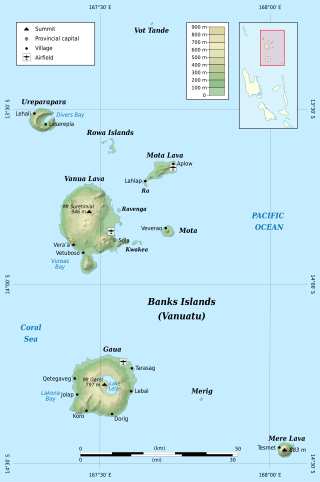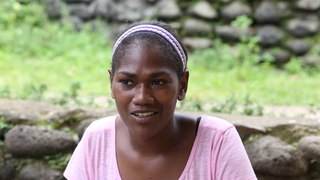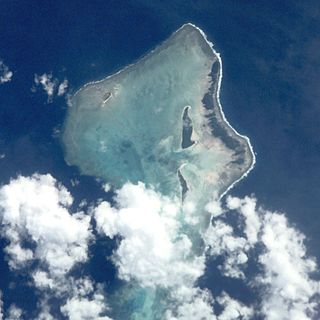
Torba is the northernmost and least populous province of Vanuatu. It consists of the Banks Islands and the Torres Islands.

The Banks Islands are a group of islands in northern Vanuatu. Together with the Torres Islands to their northwest, they make up the northernmost province of Torba. The island group lies about 40 km (25 mi) north of Maewo, and includes Gaua and Vanua Lava, two of the 13 largest islands in Vanuatu. In 2009, the islands had a population of 8,533. The island group's combined land area is 780 km2.

Gaua is the largest and second most populous of the Banks Islands in Torba Province in northern Vanuatu. It covers 342 km².
Mwotlap is an Oceanic language spoken by about 2,100 people in Vanuatu. The majority of speakers are found on the island of Motalava in the Banks Islands, with smaller communities in the islands of Ra and Vanua Lava, as well as migrant groups in the two main cities of the country, Santo and Port Vila.

Mota Lava or Motalava is an island of the Banks group, in the north of Vanuatu. It forms a single coral system with the small island of Ra.
Qat is the principal god in the oral mythology of the Banks Islands, a small archipelago of northern Vanuatu, Melanesia.

Mota is an island in the Banks group of northern Vanuatu. Its population – today about 700 people – speak the Mota language, which Christian missionaries of the Anglican Church used as a lingua franca in parts of Melanesia.

Alexandre François is a French linguist specialising in the description and study of the indigenous languages of Melanesia. He belongs to Lattice, a research centre of the CNRS and École Normale Supérieure dedicated to linguistics.
The North Vanuatu languages form a linkage of Southern Oceanic languages spoken in northern Vanuatu.

Kwakéa is an islet located east of Vanua Lava in the Banks Islands, Vanuatu. It has a population of 8 people.

Merelava is an island in the Banks Islands of the Torba Province of northern Vanuatu.

Lemerig is an Oceanic language spoken on Vanua Lava, in Vanuatu.
Sola is the capital village of Torba Province in Vanuatu. It is on the island of Vanua Lava.
Mwesen is an Oceanic language spoken in the southeastern area of Vanua Lava Island, in the Banks Islands of northern Vanuatu, by about 10 speakers.

Vurës is an Oceanic language spoken in the southern area of Vanua Lava Island, in the Banks Islands of northern Vanuatu, by about 2000 speakers.
Vera'a, also known as Vatrata, is an Oceanic language spoken on the western coast of Vanua Lava Island, in the Banks Islands of northern Vanuatu.

Rowa Islands are an uninhabited archipelago in Torba Province of Vanuatu in the Pacific Ocean. The Rowa are a part of larger Banks Islands archipelago. The islands are a natural border between Melanesia and Polynesia; they are one of the most beautiful places in the South Pacific Ocean and an integral part of a vast system of atolls and reefs.
The Torres–Banks languages form a linkage of Southern Oceanic languages spoken in the Torres Islands and Banks Islands of northern Vanuatu.
Proto-Torres-Banks is the reconstructed ancestor of the seventeen languages of the Torres and Banks Islands of Vanuatu. Like all indigenous languages of Vanuatu, it belongs to the Oceanic branch of the Austronesian languages.













